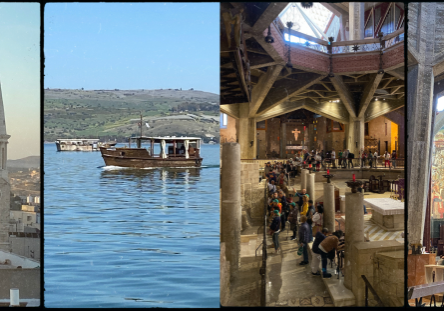The Feast of St. Nicholas
![]() By Rob Durocher, Minister of Worship and the Arts
By Rob Durocher, Minister of Worship and the Arts
For many years, he has been one of the most well-known and perhaps beloved saints in the world, but today, he is usually referred to as ‘jolly old St. Nicholas’, or by his more famous name, ‘Santa Claus’! The story of ‘Santa Claus’ really begins almost 1,750 years ago with a man named Nicholas of Bari, or Nicholas of Myra.
According to tradition Nicholas or Nikolaios of Bari was born in Patara di Licia, a maritime city in southern Turkey on March 15, 270 AD to Greek parents and died on December 6, 343 AD. Nicholas’ parents were wealthy, but they died in a pandemic that was sweeping through that area of Asia Minor when Nicholas was young. His parents raised him as a devout Christian and Nicholas became devoted to serving God by becoming a monk. While still young, tradition tells us that he also travelled to Egypt and Palestine.
It has been said that Nicholas studied scripture and holy writings and took to heart the words that Jesus spoke to the rich young man as accounted in Matthew’s Gospel to ’sell what you own and give the money to the poor.’ (Matthew 19:21) Because his parents left him such a large inheritance, Nicholas used the money and property that was left to him to do this very thing and was able to truly assist the sick, the needy and the poor. Tradition tells us that Nicholas gathered a reputation of being a kind ‘father’ to his flock and took special care of orphans and poor families. He also had a great love for children and was concerned for the well-being of sailors and ships. It has also been said that he was a ‘fierce advocate for those who had been unjustly condemned.” He understood how to not only practice but to live charity! Nicholas was recognized for his faith and good works by the surrounding churches and governments. He was eventually consecrated the Bishop of Myra while still a relatively young man.
Through the centuries, many legends and stories shaped the legacy and extraordinary character of St. Nicholas by his life and deeds that would explain why he is so beloved and honored as a protector and advocate of those in need.
One of those stories is of a poor man who had three daughters who were of marriageable age. As was the custom of the times a daughter’s father or guardian had to offer prospective husbands a dowry, or something of value. Without this a daughter was unlikely to marry and could even be sold into slavery. Nicholas was credited with throwing bags of gold through the poor man’s windows at nighttime on three different occasions, one for each daughter. Some of the gold landed in shoes or in stockings which were left before a fire to dry. This was the beginning of the custom where children would hang stockings or put out shoes out near a fire place waiting for St. Nicholas to fill them with gifts.
Another rather fantastical story tells of three theological students on their way to Athens to study who were robbed and murdered by a wicked innkeeper who hid their remains. Nicholas as Bishop of Myra was stopped at this very inn around the same time as the theological students. His sleep was disturbed that night by a dream of this crime so he got up, and summoned the innkeeper who confessed to their murder. Legend has it that as Nicholas prayed earnestly to God the three boys were restored to life and wholeness.
Nicholas’ encounter with the sea and sailors took place when as a young monk; he made a pilgrimage to the Holy Land. On returning to his homeland by sea, a severe storm brewed up that threatened to destroy the ship. The terrified sailors were amazed at how Nicholas calmly prayed for the storm to subside. Suddenly the storm was over, the waters calmed and there was no damage done to the vessel or to the sailor’s lives. It was this ‘event’ that would make St. Nicholas the patron of sailors and voyagers but would also contribute to his being named as the Bishop of Myra. Many other stories have been passed through the ages recounting Nicholas’ works and faith where he did many kind and generous deeds and expected nothing in return.
Tradition also tells us that Nicholas was caught up in the socio-political net of the Emperor Diocletian’s persecution of Christians when he was arrested and imprisoned and experienced first-hand the tortures and trials of injustice. He was released during the reign of the Emperor Constantine the Great. Historically, it is thought that he attended the first Council of Nicea in 325 AD whose purpose was to eliminate certain doctrines, heresies and conflicts that were causing confusion and division within the church. It would be out of this council that the NICEAN CREED would be formulated. Anecdotally, it was during the Council of Nicea when Nicholas slapped the face of one of those ‘heretics’ named Arius whose very heresies was causing division in the church. Some of what we know about St. Nicholas is through the writings of Andrew of Crete and John Damascene. They wrote that St. Nicholas was deeply rooted in the principles of Catholic orthodoxy, and this gives us a glimpse of the real St. Nicholas’ deeply spiritual life.
When Nicholas died on December 6, 343 AD, he never would have imagined that in less than a century a shrine in Myra for pilgrimage would be made to his honor and Basilicas in Constantinople and Bari would be dedicated to him. Less known is when St. Nicholas was canonized into sainthood since St. Nicholas became recognized as a saint long before the Roman Catholic Church began the regular canonizing procedures in the late 10th century so he does not have a specific date of canonization. He also would not imagine how his character would be reshaped almost two thousand years later!
Over the centuries St. Nicholas became well known in the West as the beloved gift-giving saint of children. The pathway from the character of St. Nicholas of old to what he would eventually become today is a bit of a shaky path, but one that can be traced. After his death, St. Nicholas’ popularity spread throughout Europe and parents and children would in turn celebrate the Feast of St. Nicholas in his honor. Although the celebration of saints would decline during the Protestant Reformation, some countries kept the practice of celebrating St. Nicholas. In the Netherlands, St. Nicholas was known as Sinterklass, shown wearing a long red robe and a red miter or bishop’s hat on his head. The children would leave shoes out for Sinterklass the night before December 6 with hopes that he would leave little gifts for them. When the Dutch came to the American Colonies they brought the story and tradition of Sinterklass with them. The English-speaking colonists would change his name to Santa Claus.
By the early 20th century, partly because of several popularized poems, Santa Claus merged with the Christmas holiday and he was now seen in a red fur suit climbing down chimneys on Christmas Eve bringing gifts to children. Today all across Europe and even in this country, the Feast of St. Nicholas is still celebrated on December 6.
Once known as a kind, revered charitable bishop, Saint Nicholas has somehow morphed into the Santa Claus that we know today. It would be too easy to just accept this ‘newer version’, but we cannot allow our ‘illusion’ of St. Nicholas today cloud the fact that through the centuries, because of the richness of his life, faith and ministry, St. Nicholas remains a ‘model of a life full of compassion’ because of his selfless generosity to those in great need of justice, the downtrodden and especially to children. This is the real ‘St. Nick”, a saint and servant of God who continues to be venerated by thousands of Catholic and Orthodox worshipers and who is honored by Protestants and who’s Feast Day is remembered every December 6.
Related Posts

Holy Land Pilgrimage



